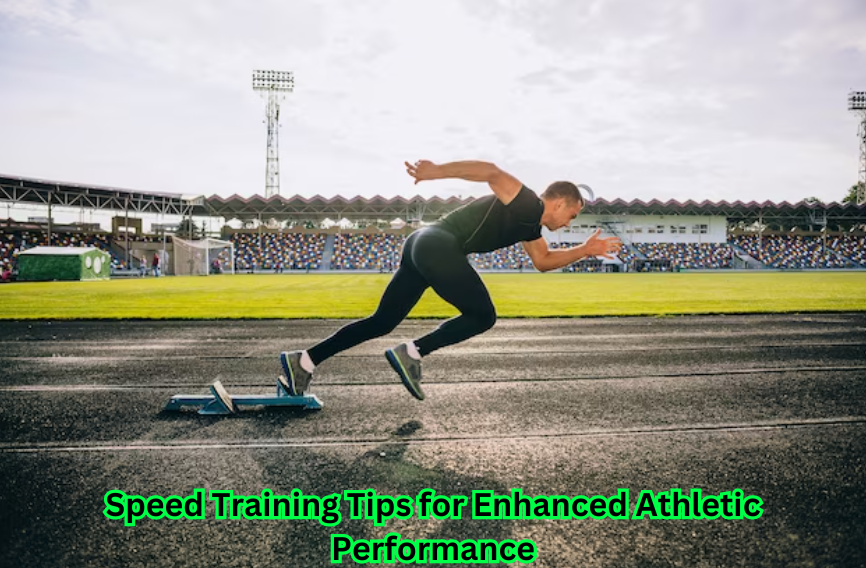Welcome to the fast lane of being a great athlete! To be your best, you must learn to move quickly. Good speed training tips can help you reach new heights, no matter how fit you are now or how long you have been working out. This complete guide delves into speed training and gives you useful advice, expert advice, and a plan to improve your physical skills. Click here.
Finding the Heart of the Matter: What Is Speed Training?
What Speed Training Means
Speed training is a specific exercise that helps athletes move quickly and efficiently. It is more than just running; it includes different ways to improve your general speed, regularity, and stride length. Everyone who wants to get ahead in a race can use the basic ideas of speed training, from sprinters on the track to varsity players.
Important Parts of Speed Training
The Propellant for Explosive Power
Explosive power, or the ability to make force quickly, makes speed possible. Do activities like plyometrics, box jumps, and medicine ball throws to get stronger quickly. These moves not only help your muscles work better, but they also help you go faster and accelerate better.
Technique Improvement: How to Get Things Done Quickly
A technique that works well is the key to speed. Focus on good form and physics, and break down how you run or move. For example, changing how your arms move and where you put your feet can make a big difference. Watching videos and getting help from a teacher can help you improve your skills.
Mastering Transitions: Speeding Up and Slowing Down
Speed is not just how fast you can go but also how quickly you can speed up and slow down. As part of your routine, do interval training by switching between short bursts of high-intensity runs and short rest times. This speeds you up and makes it easier to control your speed when you slow down.

Important Tips for Speed Training
Smart Warm-Up: Starting the Engine
Make sure your body is ready to go before you start speed training. A dynamic warm-up with leg swings, dynamic stretching, and light running gets your core body temperature up and more blood to your muscles and prepares your nervous system for the demands of speed training.
Progressive Overload: Why You Need to Step It Up
One of the most important ideas in speed training is advanced pressure. Change things like distance, length, and pressure during your workouts to gradually make them harder. This method keeps you from hitting a limit and keeps pushing your body to change and get better.
Recovery Is Important: Quality Rather Than Quantity
When speed training, people often do not give themselves enough time to heal. Your muscles need time to heal and get used to the stress of hard workouts. Make sure you plan rest days and make getting enough sleep a priority. Moving your muscles around, like light running or swimming, can also help them heal.
Making a plan for your speed training
Making Workouts Fit Your Sport
For each sport, you need a different kind of speed. It would be best if you changed your speed training plan to fit the needs of your sport. For instance, a football player might focus on fast, powerful runs, while a long-distance runner might use interval training to keep their speed up over long distances.
Adding Variety: Breaking Up Boredom
Stuck in a rut can stop growth. Adding different workouts to your speed training routine will keep it interesting and hard. Hill runs, ladder drills, and lateral moves can all help you work out other muscle groups and become more agile overall.
Getting ready for peak performance
How to Eat Fast: Fueling the Sprint
The fuel that drives your speed training is a good diet. A diet high in carbs will give you energy, lean meats will help your muscles heal, and healthy fats will improve your general performance. Just as important is staying fresh. Ensure you drink enough water before, during, and after your speed workouts.
How to Track Progress: Key Performance Indicators
Adding measures to your training routine will help you track how fast you are getting. Use timing gates or wrist tech to keep track of distance and speed for running times. Regular tests give you useful information about your growth and help you make your training plan better.
Conclusion: Sprinting Towards Success with Speed Training
Finally, speed training is not just for professional players; it is a useful tool for anyone who wants to improve their athletic ability. These speed training tips will help you get faster if you wish to cut seconds off your sprint time or just move more quickly in your sport.
So, put on your running shoes, go to the track, and enjoy the exciting journey of speed training. Your best performance is just around the corner. If you work hard, train smart, and remember these key ideas, you will be racing to success in no time.
FAQ:
Welcome to the complete guide to speed training, an exciting way to improve at sports. Find out how to master speed with these useful tips, expert advice, and answers to common questions in this Frequently Asked Questions (FAQs) section. Join us as we explore the exciting world of speed training and take your ability to new heights, whether you are an experienced athlete or a beginner.

How Can Athletes Train Faster?
Speed-boosting athletes can use specific training:
1. Sprint Workouts: Practice frequent sprints of varied distances.
Practice explosive starts, good form, and speed progression.
2. Incorporate plyometric exercises such as box jumps and forceful leaps.
These workouts build muscle and speed up movement.
3. Resistance Training: Focus on lower body strength training.
Squats, lunges, and hamstring curls increase force.
4. Implement agility workouts with directional shifts.
This improves coordination, reflexes, and speed.
How to Improve Athleticism Fast?
Improving athleticism quickly requires many approaches:
1. High-Intensity Interval Training (HIIT): Enjoy HIIT workouts for rapid cardiovascular improvement.
Short bursts of hard activity and relaxation improve athleticism.
2. Sport-Specific Training: Adapt training to match sport needs.
Sports-specific exercises increase abilities and performance.
3. Diversify your training by engaging in activities outside your major sport.
Cross-training breaks up monotony, focuses on different muscle areas, and boosts fitness.
4. Optimize Nutrition: Feed your body with nutritious food.
Rapid athletic improvement requires adequate protein, carbs, and water.
How do you become faster in athletics?
Focus is essential for athletic speed improvement:
1. Technique Refinement: Perfect your running or movement technique.
Proper form reduces resistance and boosts speed.
2. Speed Endurance Training: Grow sprint sessions progressively to enhance speed endurance.
This maintains speed over extended distances.
3. Mental Preparation: Build a solid mental game.
Visualization, positive affirmations, and focus boost performance and confidence.
4. Recovery Priority:
To avoid tiredness and injury, recuperate first.
Sustainable speed improvements require sleep, stretching, and recovery.
Which Speed Training Method Is Best?
The finest speed training is holistic:
First, implement periodized training schedules with varied intensities.
This reduces fatigue and boosts competition performance.
Step 2: Include focused drills that promote speed and agility.
Straight-line sprints, ladder drills, and cone drills improve speed.
3. Consistent Speed Workouts: Consistency is crucial.
Speed training reinforces neuromuscular adaptations and prevents performance plateaus.
4. Seek Professional Guidance: Contact a coach or trainer.
Professional supervision optimizes speed increases with specific programs and adjustments.
Adding these tactics to your training will boost speed and athletic performance. Do not give up; stay committed, and enjoy each speed milestone. Read more.

